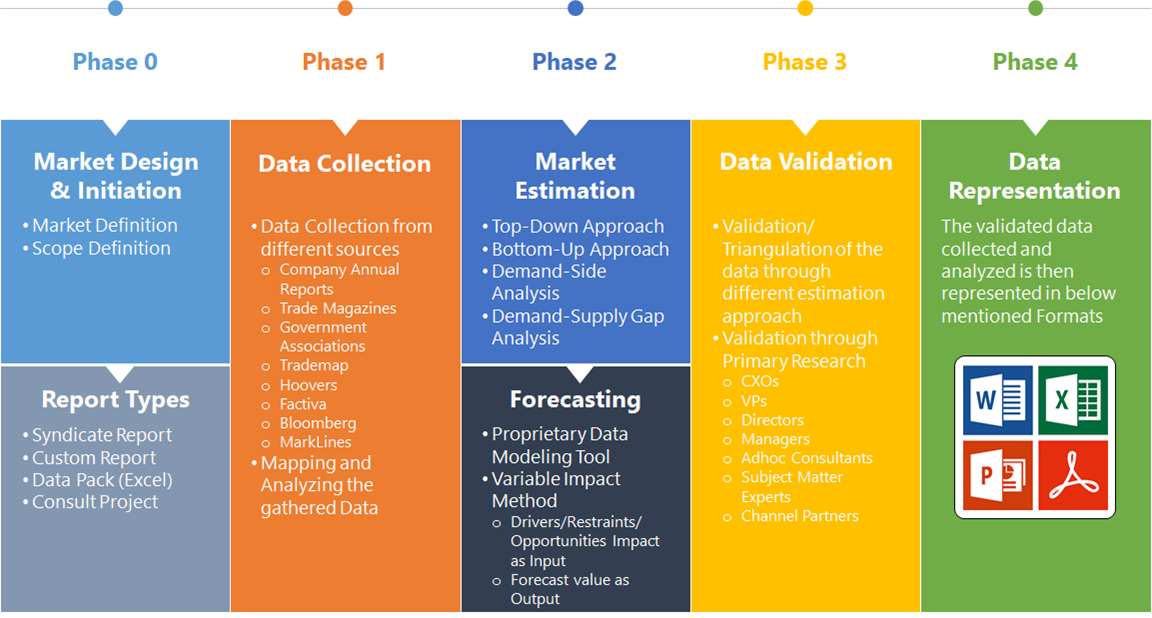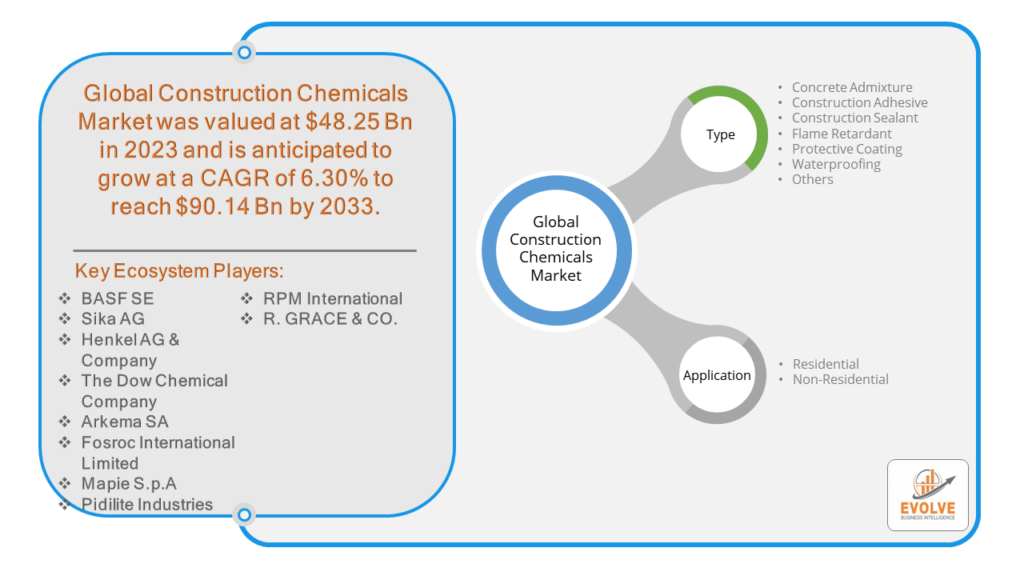Construction Chemicals Market Analysis and Global Forecast 2023-2033
$ 1,390.00 – $ 5,520.00Price range: $ 1,390.00 through $ 5,520.00
Construction Chemicals Market Research Report: Information By Type (Concrete Admixture, Construction Adhesive, Construction Sealant, Flame Retardant, Protective Coating, Waterproofing, and Others) By Application (Residential and Non-Residential), and by Region — Forecast till 2033
Page: 145
Construction Chemicals Market Overview
The Construction Chemicals Market Size is expected to reach USD 90.14 Billion by 2033. The Construction Chemicals industry size accounted for USD 48.25 Billion in 2023 and is expected to expand at a compound annual growth rate (CAGR) of 6.30% from 2023 to 2033. Chemical compounds known as “construction chemicals” are employed in construction projects to alter the characteristics of building materials. To make a structure more workable, perform better, add usefulness, and give it strength and longevity, construction chemicals are added with building materials like cement and concrete. In order to improve the building materials’ strength, quality, and longevity as well as to shield them from air deterioration and keep them cohesive, construction chemicals are applied. Road and bridge building, airport and metro transit development, as well as industrial, commercial, and residential building and rehabilitation projects, all require the usage of construction chemicals. Both new construction and historic building repairs require the use of construction chemicals.
Global Construction Chemicals Market Synopsis
The COVID-19 pandemic significantly disrupted the construction chemicals market, causing supply chain interruptions and project delays. Reduced construction activities and workforce limitations led to a temporary decline in demand. However, as economies began to recover and construction activities resumed, the market started to regain momentum, driven by increased infrastructure projects and renovation activities.
Construction Chemicals Market Dynamics
The major factors that have impacted the growth of Construction Chemicals are as follows:
Drivers:
Ø Increasing Demand for Admixtures
Concrete’s qualities can be improved by the use of additives. A substance added to concrete in addition to cement, water aggregates, and additives like slang or pozzolana is known as an additive. Concrete can be mixed with additives either during or before the mixing process. According to their functions, admixtures can be classified as bonding, waterproofing, superplasticizer, coloring, damp proofing, air-entraining, retarding, accelerating, plasticizing, water-reducing, corrosion inhibition, workability enhancement, offsetting, dispersing alkali-silica reactivity reduction, and offsetting.
Restraint:
- Fluctuating Raw Material Prices
One of the primary challenges is the volatility in the prices of raw materials used in construction chemicals, such as petrochemicals, polymers, and additives. These price fluctuations can be attributed to factors like changes in crude oil prices, geopolitical tensions, and supply chain disruptions. High raw material costs can reduce profit margins for manufacturers and lead to increased prices for end consumers, which can dampen market demand
Opportunity:
⮚ Technological Advancements and Innovation
Advances in construction technology, including nanotechnology, polymer science, and smart materials, are driving the development of high-performance construction chemicals. Types like self-healing concrete, advanced sealants, and smart coatings that respond to environmental changes are examples of innovations that provide superior performance and durability. These technological advancements offer significant market potential by addressing specific construction challenges and enhancing the lifespan of structures.
Construction Chemicals Segment Overview
By Type
Based on Type, the market is segmented based on Concrete Admixture, Construction Adhesive, Construction Sealant, Flame Retardant, Protective Coating, Waterproofing, and Others. the concrete admixture is expected to have the largest share in the market. The concrete admixture is extensively used for reducing water content in concrete and enhance durability. The different types of admixtures include lingo-based admixtures, Sulfonated Naphthalene Formaldehyde (SNF), and Sulfonated Melamine Formaldehyde (SMF). Construction adhesives are expected to show prominent growth as they enhance the durability and bonding duration of adhesive. The different adhesives include cement-based adhesive, epoxy adhesive and polymer formulated adhesive.
By Application
 Based on Applications, the market has been divided into the Residential and Non-Residential. The non-residential segment is anticipated to show lucrative growth owing to rapid urbanization in emerging economies.
Based on Applications, the market has been divided into the Residential and Non-Residential. The non-residential segment is anticipated to show lucrative growth owing to rapid urbanization in emerging economies.
Global Construction Chemicals Market Regional Analysis
Based on region, the global Construction Chemicals market has been divided into North America, Europe, Asia-Pacific, the Middle East & Africa, and Latin America. Asia-Pacific is projected to dominate the use of the Construction Chemicals market followed by the North America and Europe regions.
 Construction Chemicals Asia-Pacific Market
Construction Chemicals Asia-Pacific Market
Asia-Pacific holds a dominant position in the Construction Chemicals Market. Because of the growing infrastructure development, the Asia-Pacific region is anticipated to lead the construction chemicals market. Furthermore, it is anticipated that government programs supporting infrastructure development will fuel the expansion of the construction chemicals market in the upcoming years. Demand for construction chemicals is anticipated to be driven throughout the forecast period by the established infrastructure industry in North America, which provides a sizable consumer base for these Types.
Construction Chemicals North America Market
The North America region has indeed emerged as the fastest-growing market for the Construction Chemicals industry. In North America, the construction chemicals market is experiencing steady growth, driven by significant investments in infrastructure development and renovation projects. The demand is bolstered by the adoption of sustainable building practices and advanced construction technologies. The region’s stringent environmental regulations also promote the use of eco-friendly construction chemicals, while the ongoing urbanization and smart city initiatives further propel market expansion.
Competitive Landscape
The global Construction Chemicals market is highly competitive, with numerous players offering a wide range of software solutions. The competitive landscape is characterized by the presence of established companies, as well as emerging startups and niche players. To increase their market position and attract a wide consumer base, the businesses are employing various strategies, such as Typelaunches, and strategic alliances.
Prominent Players:
- BASF SE
- Sika AG
- Henkel AG & Company
- The Dow Chemical Company
- Arkema SA
- Fosroc International Limited
- Mapie S.p.A
- Pidilite Industries
- RPM International
- GRACE & CO.
Key Development
In December 2018, Fosroc launched Green Roof Waterproofing Grade of Polyurea. The Polyurea WH200GR will provide waterproofing solution in minutes allowing subsequent drainage, soil, and vegetation layer to be quickly installed.
Scope of the Report
Global Construction Chemicals Market, by Type
- Concrete Admixture
- Construction Adhesive
- Construction Sealant
- Flame Retardant
- Protective Coating
- Waterproofing
- Others
Global Construction Chemicals Market, by Application
- Residential
- Non-Residential
Global Construction Chemicals Market, by Region
- North America
- US
- Canada
- Mexico
- Europe
- UK
- Germany
- France
- Italy
- Spain
- Benelux
- Nordic
- Rest of Europe
- Asia Pacific
- China
- Japan
- South Korea
- Indonesia
- Austalia
- Malaysia
- India
- Rest of Asia Pacific
- South America
- Brazil
- Argentina
- Rest of South America
- Middle East & Africa
- Saudi Arabia
- UAE
- Egypt
- South Africa
- Rest of Middle East & Africa
| Parameters | Indicators |
|---|---|
| Market Size | 2033: $90.14 Billion |
| CAGR | 6.30% CAGR (2023-2033) |
| Base year | 2022 |
| Forecast Period | 2023-2033 |
| Historical Data | 2021 |
| Report Coverage | Revenue Forecast, Competitive Landscape, Growth Factors, and Trends |
| Key Segmentations | Type, Application |
| Geographies Covered | North America, Europe, Asia-Pacific, Latin America, Middle East, Africa |
| Key Vendors | BASF SE, Sika AG, Henkel AG & Company, The Dow Chemical Company, Arkema SA, Fosroc International Limited, Mapie S.p.A, Pidilite Industries, RPM International, R. GRACE & CO. |
| Key Market Opportunities | Governments across developing countries are significantly investing in infrastructure development. |
| Key Market Drivers | Increasing investment in infrastructure development and residential construction activities across the globe • The increase in urbanization and rapid population growth. |
REPORT CONTENT BRIEF:
- High-level analysis of the current and future Construction Chemicals market trends and opportunities
- Detailed analysis of current market drivers, restraining factors, and opportunities in the future
- Construction Chemicals market historical market size for the year 2021, and forecast from 2023 to 2033
- Construction Chemicals market share analysis at each Type level
- Competitor analysis with detailed insight into its Type segment, Government & Defense strength, and strategies adopted.
- Identifies key strategies adopted including Type launches and developments, mergers and acquisitions, joint ventures, collaborations, and partnerships as well as funding taken and investment done, among others.
- To identify and understand the various factors involved in the global Construction Chemicals market affected by the pandemic
- To provide a detailed insight into the major companies operating in the market. The profiling will include the Government & Defense health of the company’s past 2-3 years with segmental and regional revenue breakup, Type offering, recent developments, SWOT analysis, and key strategies.
Press Release

Global Pharmaceutical Manufacturing Market to Reach $1.38 Trillion by 2035 with 7.35% CAGR, New Research Shows

The Global Mammography Market Is Estimated To Record a CAGR of Around 10.29% During The Forecast Period

Glue Stick Market to Reach USD 2.35 Billion by 2034

Podiatry Service Market to Reach USD 11.88 Billion by 2034

Microfluidics Technology Market to Reach USD 32.58 Billion by 2034

Ferric Chloride Market to Reach USD 10.65 Billion by 2034

Family Practice EMR Software Market to Reach USD 21.52 Billion by 2034

Electric Hairbrush Market to Reach USD 15.95 Billion by 2034

Daily Bamboo Products Market to Reach USD 143.52 Billion by 2034

Cross-border E-commerce Logistics Market to Reach USD 112.65 Billion by 2034
Frequently Asked Questions (FAQ)
What is the study period of the Construction Chemicals Market?
The study period for the Construction Chemicals Market is from 2023 to 2033.
What is the growth rate of the Construction Chemicals Market?
The Construction Chemicals Market is expected to grow at a compound annual growth rate (CAGR) of 6.30% from 2023 to 2033.
Which region has the highest growth rate in the Construction Chemicals Market?
North America has the highest growth rate in the Construction Chemicals Market.
Which region has the largest share of the Construction Chemicals Market?
The Asia-Pacific region holds the largest share of the Construction Chemicals Market.
Who are the key players in the Construction Chemicals Market?
Key players in the Construction Chemicals Market include BASF SE, Sika AG, Henkel AG & Company, The Dow Chemical Company, and Arkema SA.
Do you offer Post sales support?
Yes, we offer 16 hours of analyst support to solve the queries
Do you sell particular sections of a report?
Yes, we provide regional as well as country-level reports. Other than this we also provide a sectional report. Please get in contact with our sales representatives.
Table of Content
Chapter 1. Executive Summary Chapter 2. Scope Of The Study 2.1. Market Definition 2.2. Scope Of The Study 2.2.1. Objectives of Report 2.2.2. Limitations 2.3. Market Structure Chapter 3. Evolve BI Methodology Chapter 4. Market Insights and Trends 4.1. Supply/ Value Chain Analysis 4.1.1. Raw Applications Providers 4.1.2. Manufacturing Process 4.1.3. Distributors/Retailers 4.1.4. End-Use Industry 4.2. Porter’s Five Forces Analysis 4.2.1. Threat Of New Entrants 4.2.2. Bargaining Power Of Buyers 4.2.3. Bargaining Power Of Suppliers 4.2.4. Threat Of Substitutes 4.2.5. Industry Rivalry 4.3. Impact Of COVID-19 on the Construction Chemicals Market 4.3.1. Impact on Market Size 4.3.2. End-Use Industry Trend, Preferences, and Budget Impact 4.3.3. Regulatory Framework/Government Policies 4.3.4. Key Players' Strategy to Tackle Negative Impact 4.3.5. Opportunity Window 4.4. Technology Overview 12.28. Macro factor 4.6. Micro Factor 4.7. Demand Supply Gap Analysis of the Construction Chemicals Market 4.8. Import Analysis of the Construction Chemicals Market 4.9. Export Analysis of the Construction Chemicals Market Chapter 5. Market Dynamics 5.1. Introduction 5.2. DROC Analysis 5.2.1. Drivers 5.2.2. Restraints 5.2.3. Opportunities 5.2.4. Challenges 5.3. Patent Analysis 5.4. Industry Roadmap 5.5. Parent/Peer Market Analysis Chapter 6. Global Construction Chemicals Market, By Type 6.1. Introduction 6.2. Concrete Admixture 6.3. Construction Adhesive 6.4. Construction Sealant 6.5. Flame Retardant 6.6. Protective Coating 6.7. Waterproofing 6.8. Others Chapter 7. Global Construction Chemicals Market, By Application 7.1. Introduction 7.2. Residential 7.3. Non-Residential Chapter 8. Global Construction Chemicals Market, By Region 8.1. Introduction 8.2. North America 8.2.1. Introduction 8.2.2. Driving Factors, Opportunity Analyzed, and Key Trends 8.2.3. Market Size and Forecast, By Country, 2023-2033 8.2.4. Market Size and Forecast, By Type,2023-2033 8.2.5. Market Size and Forecast, By Application, 2023-2033 8.2.6. US 8.2.6.1. Introduction 8.2.6.2. Driving Factors, Opportunity Analyzed, and Key Trends 8.2.6.3. Market Size and Forecast, By Type,2023-2033 8.2.6.4. Market Size and Forecast, By Application, 2023-2033 8.2.7. Canada 8.2.7.1. Introduction 8.2.7.2. Driving Factors, Opportunity Analyzed, and Key Trends 8.2.7.4. Market Size and Forecast, By Type,2023-2033 8.2.7.5. Market Size and Forecast, By Application, 2023-2033 8.3. Europe 8.3.1. Introduction 8.3.2. Driving Factors, Opportunity Analyzed, and Key Trends 8.3.3. Market Size and Forecast, By Country, 2023-2033 8.3.4. Market Size and Forecast, By Type,2023-2033 8.3.5. Market Size and Forecast, By Application, 2023-2033 8.3.6. Germany 8.3.6.1. Introduction 8.3.6.2. Driving Factors, Opportunity Analyzed, and Key Trends 8.3.6.3. Market Size and Forecast, By Type,2023-2033 8.3.6.4. Market Size and Forecast, By Application, 2023-2033 8.3.7. France 8.3.7.1. Introduction 8.3.7.2. Driving Factors, Opportunity Analyzed, and Key Trends 8.3.7.3. Market Size and Forecast, By Type,2023-2033 8.3.7.4. Market Size and Forecast, By Application, 2023-2033 8.3.8. UK 8.3.8.1. Introduction 8.3.8.2. Driving Factors, Opportunity Analyzed, and Key Trends 8.3.8.3. Market Size and Forecast, By Type,2023-2033 8.3.8.4. Market Size and Forecast, By Application, 2023-2033 8.3.9. Italy 8.3.9.1. Introduction 8.3.9.2. Driving Factors, Opportunity Analyzed, and Key Trends 8.3.9.3. Market Size and Forecast, By Type,2023-2033 8.3.9.4. Market Size and Forecast, By Application, 2023-2033 8.3.11. Rest Of Europe 8.3.11.1. Introduction 8.3.11.2. Driving Factors, Opportunity Analyzed, and Key Trends 8.3.11.3. Market Size and Forecast, By Type,2023-2033 8.3.11.4. Market Size and Forecast, By Application, 2023-2033 8.4. Asia-Pacific 8.4.1. Introduction 8.4.2. Driving Factors, Opportunity Analyzed, and Key Trends 8.4.3. Market Size and Forecast, By Country, 2023-2033 8.4.4. Market Size and Forecast, By Type,2023-2033 8.12.28. Market Size and Forecast, By Application, 2023-2033 8.4.6. China 8.4.6.1. Introduction 8.4.6.2. Driving Factors, Opportunity Analyzed, and Key Trends 8.4.6.3. Market Size and Forecast, By Type,2023-2033 8.4.6.4. Market Size and Forecast, By Application, 2023-2033 8.4.7. India 8.4.7.1. Introduction 8.4.7.2. Driving Factors, Opportunity Analyzed, and Key Trends 8.4.7.3. Market Size and Forecast, By Type,2023-2033 8.4.7.4. Market Size and Forecast, By Application, 2023-2033 8.4.8. Japan 8.4.8.1. Introduction 8.4.8.2. Driving Factors, Opportunity Analyzed, and Key Trends 8.4.8.3. Market Size and Forecast, By Type,2023-2033 8.4.8.4. Market Size and Forecast, By Application, 2023-2033 8.4.9. South Korea 8.4.9.1. Introduction 8.4.9.2. Driving Factors, Opportunity Analyzed, and Key Trends 8.4.9.3. Market Size and Forecast, By Type,2023-2033 8.4.9.4. Market Size and Forecast, By Application, 2023-2033 8.4.10. Rest Of Asia-Pacific 8.4.10.1. Introduction 8.4.10.2. Driving Factors, Opportunity Analyzed, and Key Trends 8.4.10.3. Market Size and Forecast, By Type,2023-2033 8.4.10.4. Market Size and Forecast, By Application, 2023-2033 8.5. Rest Of The World (RoW) 8.5.1. Introduction 8.5.2. Driving Factors, Opportunity Analyzed, and Key Trends 8.5.3. Market Size and Forecast, By Type,2023-2033 8.5.4. Market Size and Forecast, By Application, 2023-2033 Chapter 9. Company Landscape 9.1. Introduction 9.2. Vendor Share Analysis 9.3. Key Development Analysis 9.4. Competitor Dashboard Chapter 10. Company Profiles 10.1. BASF SE 10.1.1. Business Overview 10.1.2. Government & Defense Analysis 10.1.2.1. Government & Defense – Existing/Funding 10.1.3. TypePortfolio 10.1.4. Recent Development and Strategies Adopted 10.1.5. SWOT Analysis 10.2. Sika AG 10.2.1. Business Overview 10.2.2. Government & Defense Analysis 10.2.2.1. Government & Defense – Existing/Funding 10.2.3. TypePortfolio 10.2.4. Recent Development and Strategies Adopted 10.2.5. SWOT Analysis 10.3. Henkel AG & Company 10.3.1. Business Overview 10.3.2. Government & Defense Analysis 10.3.2.1. Government & Defense – Existing/Funding 10.3.3. TypePortfolio 10.3.4. Recent Development and Strategies Adopted 10.3.5. SWOT Analysis 10.4. The Dow Chemical Company 10.4.1. Business Overview 10.4.2. Government & Defense Analysis 10.4.2.1. Government & Defense – Existing/Funding 10.4.3. TypePortfolio 10.4.4. Recent Development and Strategies Adopted 10.12.28. SWOT Analysis 10.5. Arkema SA 10.5.1. Business Overview 10.5.2. Government & Defense Analysis 10.5.2.1. Government & Defense – Existing/Funding 10.5.3. TypePortfolio 10.5.4. Recent Development and Strategies Adopted 10.5.5. SWOT Analysis 10.6. Fosroc International Limited 10.6.1. Business Overview 10.6.2. Government & Defense Analysis 10.6.2.1. Government & Defense – Existing/Funding 10.6.3. TypePortfolio 10.6.4. Recent Development and Strategies Adopted 10.6.5. SWOT Analysis 10.7. Mapie S.p.A 10.7.1. Business Overview 10.7.2. Government & Defense Analysis 10.7.2.1. Government & Defense – Existing/Funding 10.7.3. TypePortfolio 10.7.4. Recent Development and Strategies Adopted 10.7.5. SWOT Analysis 10.8 Pidilite Industries 10.8.1. Business Overview 10.8.2. Government & Defense Analysis 10.8.2.1. Government & Defense – Existing/Funding 10.8.3. TypePortfolio 10.8.4. Recent Development and Strategies Adopted 10.8.5. SWOT Analysis 10.9 RPM International 10.9.1. Business Overview 10.9.2. Government & Defense Analysis 10.9.2.1. Government & Defense – Existing/Funding 10.9.3. TypePortfolio 10.9.4. Recent Development and Strategies Adopted 10.9.5. SWOT Analysis 10.10. R. GRACE & CO.. 10.10.1. Business Overview 10.10.2. Government & Defense Analysis 10.10.2.1. Government & Defense – Existing/Funding 10.10.3. TypePortfolio 10.10.4. Recent Development and Strategies Adopted 10.10.5. SWOT Analysis
Connect to Analyst
Research Methodology








